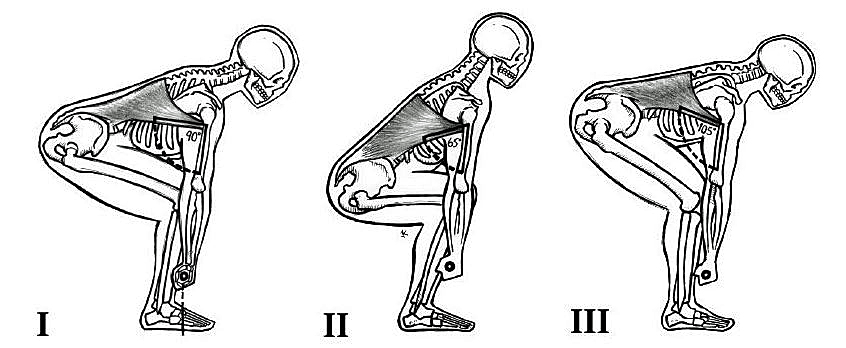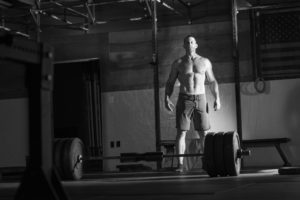OPEN WOD 18.4
A new standard for measuring the HSPU line is in effect for Open WOD 18.4. Oh, and there’s a new movement making its first appearance; Handstand Walks are now in the open. Deadlifts make another appearance, and the weights will increase.
For Time (9 min cap):
Reps 21-15-9
Deadlifts (225/155)
HSPU
21-15-9 – Deadlifts (315/205)
50 ft Handstand Walk after each set
In the 2012 Regionals, “Diane” was programmed with a 9-min time cap, and many people didn’t even finish it (but Dan Bailey did complete the entire workout in 1:35, no big deal). Now this Open workout is programmed with additional heavier deadlifts AND Handstand Walks with a 9-minute cap. The sport has EVOLVED!
Nutrition
Heavy, hard and fast. Extra carbs the night before for sure! This is a highly nervous system intensive workout. It is NOT ideal to complete this workout fasted. It is not ideal to complete this workout in the morning, either. The spine will be more compressed, and the nervous system will be impacted more.
Pre-workout meals, same as 18.2. Lots of protein and carbs 1-2 hours prior. Make sure to overeat carbs following the workout, as well. This will help increase recovery and create slightly less soreness in the following days. This is vital, especially if you think you might need to redo it again.
Initial Preparation Concerns
The warm-up should consist of “general warm-up” (per usual) to get a light sweat going for about 10 minutes. You can use the Rower or the Airdyne. I am a proponent of the Rower because it involves a similar drive through the heels and hip extension that we will use in the deadlift during the workout. It’s important to get your heart rate elevated by completing 3-4 intense “intervals” for 10-20 sec. This will prepare the body for the work ahead.
Next, you will need to ensure your hamstrings, hips, low back, glutes and shoulders are all mobilized. The usual approach of lacrosse ball, foam roller, band pull-aparts, inch-worms should work quite well. Make sure to practice some handstand holds, and feel the proper way in which the shoulders engage. Start shifting side to side and implement some “shoulder touches” from the inverted position. This will help you feel the necessary balance points for the HSPU and HS Walks.
Hamstring flexibility will be extremely important to keep proper position during the deadlifts. This will help you be more efficient and use the proper musculature during the reps (more on proper form later). Hamstring mobility can be aided by banded hamstring stretches, as well as incorporating some LIGHT RDL’s, focusing on increasing range of motion on each rep.
Make sure to practice handstand walks prior to the workout. Wait until you are warmed up and feeling confident (more on handstand walk technique later).
Before the specific prep for the workout, I believe that warming up with some heavy singles on Power Clean will really help your cause. Don’t fail reps or try to set a PR. The explosiveness from the movement will prep the CNS and will transfer over to the Deadlifts and other movements.
Finally, getting into the specific prep, the following two movement sequence will provide sufficient technical warm-up for the workout itself:
2 Rounds (rest 3 min) repeat 2 rounds:
4 Deadlifts (225/155)
4 HSPU (to standard)
Pacing
This is my favorite topic every week. I love how aggressively people attack workouts the first time, and then they reflect on it, and realize they should have paced more. Understand that pacing doesn’t mean taking long rests between sets. Pacing means strategically breaking movements with planned short rest so that you don’t have to spend a ton of time recovering later in the workout. In this workout, my pacing advice is pretty much relevant to everyone INCLUDING the top regionals and games athletes:
BREAK YOUR DEADLIFTS EARLY AND OFTEN
If you are extremely fit, just rest for less when you break sets – but the same principles of sustainability apply. I predicted Scott Panchik would break his deadlifts at 225, and I was absolutely right. He literally broke it FOUR TIMES in the set of 21 reps. He broke it THREE times in the set of 15 reps. Take a guess how many reps he was behind when he finished the 21-15-9 of “Diane?” The answer is ONE REP. Any time you think you will save by going unbroken early will punish you later in the workout. When will people realize that breaking reps is not a sign of weakness? It’s a sign of intelligence and a demonstration of pacing mastery.
Furthermore, these workouts are not scored separately. There is ONE big score at the end of the workout. A slower pace on the first 21-15-9 will not negatively impact your overall result, but completing the first part too fast will absolutely impact your ability to move quickly in the latter stages of the workout.
The same principles apply to the Handstand Push-up. In both movements, you MUST break the sets a few reps PRIOR to the really difficult rep. If you try to grind out a difficult rep, it will be that much longer before you can get back to the movement. Do not fatigue yourself into failure.
The Movements
The Deadlifts will be aided tremendously by utilizing the proper muscles. This movement is a “hip hinge,” meaning you are meant to bow to the ground and then stand up, using your back, glutes and hamstrings. This is NOT a squatty type movement, and the quads should act primarily as a stabilizing muscle. Talk to your coaches about this, because you will save energy and shorten range of motion (ROM) by performing these reps properly. Everyone’s body type is different, and the proper deadlift form will depend on the specifics of your anthropometric makeup.
I already discussed the pacing side of the deadlifts above. Please read and re-read the pacing section. The only scenario in which you would consider going with bigger sets on the deadlifts would be if you know you cannot deadlift the second weight, and you are extremely proficient at HSPU.
This workout is all about the midline being stable. This stability in your midline is crucial to ensure balance and sustainability in the HSPU and handstand walks. Wrecking yourself on the first 45 reps of deadlift is a bad idea.
The HSPU biggest concern is the standard that we must meet. The measuring mechanism is different, but you must still ensure the heels clear the tape line on the wall. From what I’ve heard, this standard is MORE DIFFICULT than the old standard, and leaves less room for error. You basically have to keep your hands narrow enough to ensure that you can make consistent good reps.
A common problem for many athletes is the tendency to keep the butt on the wall at the top of the rep. This will SHORTEN your body length, and make it difficult to meet the standard. You must keep your body hollow and as vertical as possible at the top of the rep. Make sure you dial in solid technique and keep your core tight so that your heels can clear the line on every rep.
Another key to making consistently good reps is to remember to point your toes DOWN toward the ground at the top of the rep. This will in effect raise the heels to the acceptable line level. Also, don’t forget that you have to ESTABLISH the heels over line BEFORE you descend down every time you kick up onto the wall. Don’t make the error of dropping to the bottom and having to do an extra HSPU just to begin your set legally.
If you rest on your head, you will shorten yourself temporarily, and this will make it even harder to get up high enough and pass the line. When you rest, kick off the wall briefly, unless you are just trying to make the last rep or two of a set.
Shoes off! Really? Yeah – socks slide up the wall much easier than shoes do. Just make sure to measure your HSPU line with shoes off if you intend to follow this strategy. The good news is that shoes off ALSO works quite well for deadlifts, as it keeps you closer to the ground, and shortens the ROM of the movement.
If you aren’t familiar with the HSPU standard, I would spend some time practicing and mastering this standard before the workout. It is going to be a waste to try and figure it out during the workout. Have somebody watch you and tell you whether you are successfully making reps, or not.
Only advice on the rep scheme is to avoid failure. Stop and shake it out prior to this point and you will be able to get back on the wall sooner. Everyone is different, but staying many reps shy of failure will keep you moving and ensure that every rep counts.
The Handstand Walk is a movement that you can do or not do, for the most part. If you can do them, you will be just fine, because you are allowed to drop down and reset every 5 feet. Just make sure you pace properly up to the movement so that you are not too fatigued. If you are not great with this movement, you can always try the launch yourself forward approach, and try to stay stable and upright long enough to clear the 5-foot line; then rinse and repeat. For most people, just getting to this section, and clearing your way through 21 reps of 315/205 deadlifts will separate you from others that cannot lift that load.
When you perform the HS walk, keep the following cues in mind:
– Press through hands and shoulders, stacking everything in vertical orientation
– Think about spreading the floor with your fingers
– Feel your body actively shift weight between your hands as you walk
The HS walks should be part of the warmup. Wait until you are sufficiently warmed up so that you create the best possible environment for success. If you know you will not make it through the heavy deadlift set, I would not waste energy practicing an irrelevant movement.




